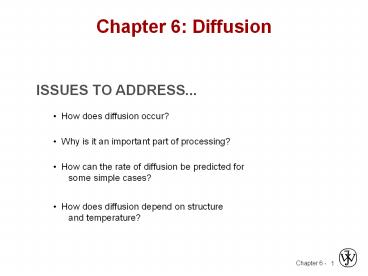Chapter 6: Diffusion - PowerPoint PPT Presentation
1 / 27
Title:
Chapter 6: Diffusion
Description:
Chapter 6: Diffusion ISSUES TO ADDRESS... How does diffusion occur? Why is it an important part of processing? How can the rate of diffusion be predicted for – PowerPoint PPT presentation
Number of Views:294
Avg rating:3.0/5.0
Title: Chapter 6: Diffusion
1
Chapter 6 Diffusion
ISSUES TO ADDRESS...
How does diffusion occur?
Why is it an important part of processing?
How can the rate of diffusion be predicted
for some simple cases?
How does diffusion depend on structure
and temperature?
2
Diffusion
- Diffusion - Mass transport by atomic motion
- Mechanisms
- Gases Liquids random (Brownian) motion
- Solids vacancy diffusion or interstitial
diffusion
3
Diffusion
Interdiffusion In an alloy, atoms tend to
migrate from regions of high conc. to
regions of low conc.
Initially
Adapted from Figs. 6.1 and 6.2, Callister
Rethwisch 3e.
4
Diffusion
Self-diffusion In an elemental solid, atoms
also migrate.
Label some atoms
5
Diffusion Mechanisms
Vacancy Diffusion
atoms exchange with vacancies applies to
substitutional impurities atoms rate depends
on -- number of vacancies --
activation energy to exchange.
6
Diffusion Simulation
This slide contains an animation that requires
Quicktime and a Cinepak decompressor. Click on
the message or image below to activate the
animation.
Simulation of interdiffusion across an
interface
Rate of substitutional diffusion depends
on -- vacancy concentration --
frequency of jumping.
(Courtesy P.M. Anderson)
7
Diffusion Mechanisms
- Interstitial diffusion smaller atoms can
diffuse between atoms.
Adapted from Fig. 6.3 (b), Callister Rethwisch
3e.
More rapid than vacancy diffusion
8
Processing Using Diffusion
Case Hardening -- Diffuse carbon atoms
into the host iron atoms at the
surface. -- Example of interstitial
diffusion is a case hardened gear.
Adapted from chapter-opening photograph, Chapter
6, Callister Rethwisch 3e. (Courtesy of Surface
Division, Midland-Ross.)
Result The presence of C atoms makes
iron (steel) harder.
9
Processing Using Diffusion
Doping silicon with phosphorus for n-type
semiconductors Process
Adapted from chapter-opening photograph, Chapter
12, Callister Rethwisch 3e.
10
Diffusion
- How do we quantify the amount or rate of
diffusion?
J ? slope
11
Steady-State Diffusion
Rate of diffusion independent of time
Flux proportional to concentration gradient
Ficks first law of diffusion
D ? diffusion coefficient
12
Example Chemical Protective Clothing (CPC)
- Methylene chloride is a common ingredient of
paint removers. Besides being an irritant, it
also may be absorbed through skin. When using
this paint remover, protective gloves should be
worn. - If butyl rubber gloves (0.04 cm thick) are used,
what is the diffusive flux of methylene chloride
through the glove? - Data
- diffusion coefficient in butyl rubber D
110 x10-8 cm2/s - surface concentrations
C1 0.44 g/cm3
C2 0.02 g/cm3
13
Example (cont).
- Solution assuming linear conc. gradient
glove
C1
paint remover
skin
C2
x1
x2
14
Diffusion and Temperature
Diffusion coefficient increases with
increasing T.
15
Diffusion and Temperature
D has exponential dependence on T
Adapted from Fig. 6.7, Callister Rethwisch 3e.
(Date for Fig. 6.7 taken from E.A. Brandes and
G.B. Brook (Ed.) Smithells Metals Reference Book,
7th ed., Butterworth-Heinemann, Oxford, 1992.)
16
Example At 300ºC the diffusion coefficient and
activation energy for Cu in Si are D(300ºC)
7.8 x 10-11 m2/s Qd 41.5 kJ/mol What is the
diffusion coefficient at 350ºC?
17
Example (cont.)
18
Non-steady State Diffusion
- The concentration of diffusing species is a
function of both time and position C C(x,t) - In this case Ficks Second Law is used
Ficks Second Law
19
Non-steady State Diffusion
Adapted from Fig. 6.5, Callister Rethwisch 3e.
B.C. at t 0, C Co for 0 ? x ? ? at t gt 0,
C CS for x 0 (constant surface conc.)
C Co for x ?
20
Solution
- C(x,t) Conc. at point x at
time t - erf (z) error function
- erf(z) values are given in Table 6.1
CS
C(x,t)
Co
21
Non-steady State Diffusion
- Sample Problem An FCC iron-carbon alloy
initially containing 0.20 wt C is carburized at
an elevated temperature and in an atmosphere that
gives a surface carbon concentration constant at
1.0 wt. If after 49.5 h the concentration of
carbon is 0.35 wt at a position 4.0 mm below the
surface, determine the temperature at which the
treatment was carried out. - Solution use Eqn. 6.5
22
Solution (cont.)
- t 49.5 h x 4 x 10-3 m
- Cx 0.35 wt Cs 1.0 wt
- Co 0.20 wt
23
Solution (cont.)
We must now determine from Table 6.1 the value of
z for which the error function is 0.8125. An
interpolation is necessary as follows
z 0.93
24
Solution (cont.)
- To solve for the temperature at which D has the
above value, we use a rearranged form of Equation
(6.9a)
25
Example Chemical Protective Clothing (CPC)
- Methylene chloride is a common ingredient of
paint removers. Besides being an irritant, it
also may be absorbed through skin. When using
this paint remover, protective gloves should be
worn. - If butyl rubber gloves (0.04 cm thick) are used,
what is the breakthrough time (tb), i.e., how
long could the gloves be used before methylene
chloride reaches the hand? - Data
- diffusion coefficient in butyl rubber
- D 110 x10-8 cm2/s
26
CPC Example (cont.)
- Solution assuming linear conc. gradient
Breakthrough time tb
Time required for breakthrough ca. 4 min
27
Summary
Diffusion FASTER for... open crystal
structures materials w/secondary
bonding smaller diffusing atoms lower
density materials
Diffusion SLOWER for... close-packed
structures materials w/covalent bonding
larger diffusing atoms higher density materials































